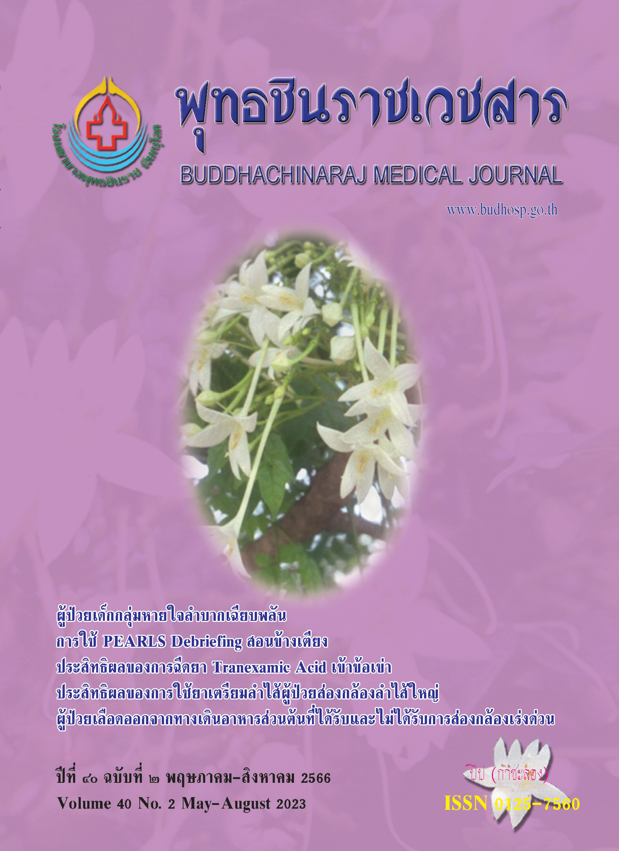ประสิทธิภาพของเครื่องมือทำนายภาวะอาการทรุดตัวเพื่อทำนายโอกาสในการใส่ ท่อช่วยหายใจหรือการนวดหัวใจผายปอดกู้ชีพผู้ป่วยหอผู้ป่วยสามัญอายุรกรรม
การใช้เครื่องมือทำนายภาวะอาการทรุดตัวเพื่อทำนายโอกาสในการใส่ท่อช่วยหายใจหรือการนวดหัวใจผายปอดกู้ชีพ
คำสำคัญ:
การใส่ท่อช่วยหายใจ, การนวดหายใจผายปอดกู้ชีพ, เครื่องมือทำนายภาวะอาการทรุดตัวบทคัดย่อ
การใส่ท่อช่วยหายใจหรือการนวดหัวใจผายปอดกู้ชีพเป็นอุบัติการณ์ที่มี อัตราตายสูง ก่อนที่ผู้ป่วยจะเกิดอุบัติการณ์จะมีสัญญาณชีพ เปลี่ยนแปลง จึงได้ใช้เครื่องมือสำหรับตรวจภาวะที่ผู้ป่วยอาการทรุดตัว ในหอผู้ป่วย เรียกว่า Early warning score (EWS) การศึกษาแบบย้อน หลังจากเวชระเบียนผู้ป่วยหอผู้ป่วยอายุรกรรมระหว่างเดือนมกราคม พ.ศ. 2563 ถึงเดือนธันวาคม พ.ศ. 2563 ครั้งนี้เพื่อเปรียบเทียบประสิทธิภาพของ EWS 3 ชนิด ได้แก่ National Early warning score (NEWS), Search Out Sepsis Score (SOS) และ Modified Early warning Score (MEWS) ในผู้ป่วยที่ได้รับการใส่ท่อช่วยหายใจ หรือผายปอดกู้ชีพในหอผู้ป่วยสามัญอายุรกรรม 120 รายและสุ่มผู้ป่วย ไม่เกิด อุบัติการณ์ 120 ราย พบว่าความไว ความจำเพาะ และ ประสิทธิภาพ (Youden Index) สูงสุดที่ 4 ชั่วโมงก่อนเกิด อุบัติการณ์ ดังนี้ NEWS ความไว 0.871 ความจำเพาะ 0.775 ประสิทธิภาพ 0.682, MEWS ความไว 0.843 ความจำเพาะ 0.783 ประสิทธิภาพ 0.681, SOS ความไว 0.643 ความจำเพาะ 0.892 ประสิทธิภาพ 0.535 ทั้งนี้เมื่อผู้ป่วย ได้รับการใส่ท่อช่วยหายใจหรือได้รับการนวดหัวใจผายปอดกู้ชีพพบว่า อัตราการเสียชีวิต, การส่งต่อ, การปฏิเสธการรักษา และจำนวนวัน นอนโรงพยาบาลสูงกว่ากลุ่มไม่เกิดอุบัติการณ์อย่างมีนัยสำคัญทางสถิติ สรุปได้ว่าประสิทธิภาพ ความไว และความจำเพาะของเครื่องมือลดลง ตามระยะเวลาที่ห่างจากอุบัติการณ์
เอกสารอ้างอิง
Sarbazi-Golezari A, Namdar P, Yousefian S, Mirzadeh M, Farnood A, Modirian E. Prognosis of patients with tracheal intubation in the emergency department. Trends Anaesth Crit Care 2021;41:81-4. doi: 10.1016/j.tacc.2021.07.008
Jerkeman M, Sultanian P, Lundgren P, Nielsen N, Helleryd E, Dworeck C, et al. Trends in survival after cardiac arrest: A Swedish nationwide study over 30 years. Eur Heart J 2022;43(46):4817–29.
Royal College of Physicians. National Early Warning Score (NEWS) 2: Standardizing the assessment of acute-illness severity in the NHS. Updated report of a working party. London, United Kingdom: RCP; 2017.
Alam N, Vegting IL, Houben E, van Berkel B, Vaughan L, Kramer MHH, et al. Exploring the performance of the National Early Warning Score (News) in a European Emergency Department. Resuscitation 2015;90:111–5. doi: 10.1016/j.resuscitation.2015.02.011
Zhang K, Zhang X, Ding W, Xuan N, Tian B, Huang T, et al. National early warning score does not accurately predict mortality for patients with infection outside the Intensive Care Unit: A systematic review and meta-analysis. Front Med 2021;8:704358. doi: 10.3389/fmed.2021.704358
Pisitsak C, Champunot R, Morakul S. The role of the hospitalists in the workforce to address the shortages of intensivists in hospitals here in Thailand. J Med Assoc Thai 2014;97(Suppl 1):S132-6.
Khwannimit B, Bhurayanontachai R, Vattanavanit V. Comparison of the accuracy of three early warning scores with SOFA score for predicting mortality in adult sepsis and septic shock patients admitted to intensive care unit. Heart Lung 2019;48(3):240–4. doi: 10.1016/j.hrtlng.2019.02.005
Smith MEB, Chiovaro JC, O'Neil M, Kansagara D, Quinones A, Freeman M, et al. Early Warning System Scores: a systematic review [Internet]. 2014 [cited 2023 Sep 8]. Available from: https://www.ncbi.nlm.nih.gov/books/NBK259029/
Nahm FS. Receiver operating characteristic curve: overview and practical use for clinicians. Korean J Anesthesiol 2022;75(1):25–36.
Yin J, Samawi H, Linder D. Improved nonparametric estimation of the optimal diagnostic cut-off point associated with the Youden index under different sampling schemes. Biometrical J 2016;58(4):915–34.
Spångfors M, Molt M, Samuelson K. In-hospital cardiac arrest and preceding National Early Warning Score (NEWS): A retrospective case-control study. Clin Med 2020;20(1):55–60.
Champunot R, Tansuphaswasdikul C, Kamsawang N, Tuandoung P, Thimsri D. Application of Search Out Severity (SOS) score for identification of deteriorating patients in general wards. Buddhachinaraj Med J 2016;33(3):313–25.
Kolic I, Crane S, McCartney S, Perkins Z, Taylor A. Factors affecting response to National Early Warning Score (NEWS). Resuscitation 2015;90:85–90. doi: 10.1016/j.resuscitation.2015.02.009
Fu L-H, Schwartz J, Moy A, Knaplund C, Kang M-J, Schnock KO, et al. Development and validation of early warning score system: A systematic literature review. J Biomed Inform 2020;105:103410. doi: 10.1016/j.jbi.2020.103410
Lyons PG, Edelson DP, Churpek MM. Rapid response systems. Resuscitation 2018;128:191–7. doi: 10.1016/j.resuscitation.2018.05.013
ดาวน์โหลด
เผยแพร่แล้ว
ฉบับ
ประเภทบทความ
สัญญาอนุญาต
ลิขสิทธิ์ (c) 2023 ``โรงพยาบาลพุทธชินราช พิษณุโลก

อนุญาตภายใต้เงื่อนไข Creative Commons Attribution-NonCommercial-NoDerivatives 4.0 International License.






